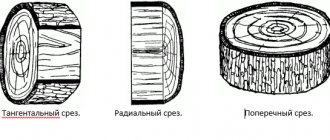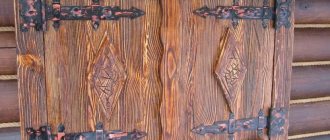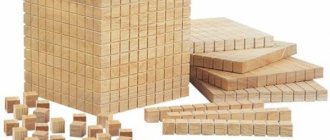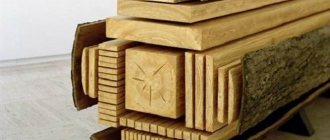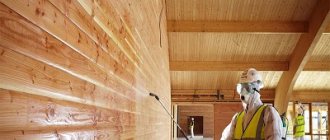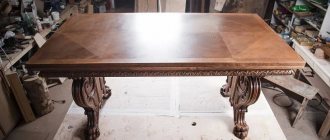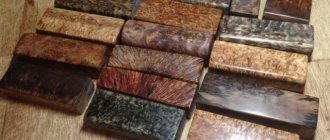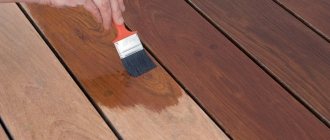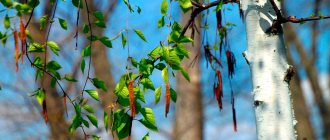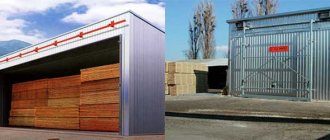As the tree grows, it fills with water from the ground through its roots. This way it absorbs nutrients that promote development. Then, when the trunk is cut down into blanks, some of the moisture remains with it. Wood moisture content should not exceed 22%. Below 15% it will not be possible to dry it naturally, since the external environment also feeds the material with liquid. The indicator of the amount of moisture affects the properties of wood and how it will behave during processing. Excessive amounts of water lead to mold and rot.
Natural humidity
The indicator is used to determine the amount of water inside the trunk immediately after cutting or during growth. It determines the quality of drying of wood materials. The natural moisture content of wood is considered the initial value, on the basis of which calculations for drying the material begin. If the indicator is determined incorrectly, there is a risk of under- or over-drying the lumber.
What percentage of water is contained in the trunk is determined by the following factors:
- wood structure;
- porosity;
- environment.
The natural moisture content of wood ranges from 30 to 80% and varies depending on the type of material. They are used as a starting point before determining the optimal drying mode to achieve the desired quality of the dry workpiece.
Deciduous wood has a lower natural moisture content than coniferous wood. This is due to the structure of wood. Spruce contains up to 90% moisture, fir contains up to 92%. For comparison, ash wood contains only 36%. In addition, the percentage of water in the material is influenced by the state of the environment. In winter, plants go into “dormant mode” and practically do not consume nutrients from the ground. Therefore, humidity in summer is much higher than in winter. Also, freshly cut wood has a much higher moisture percentage than older wood.
The task of those involved in lumber processing is to reduce moisture content to the lowest possible percentage. This is done so that the workpieces acquire the necessary hardness and strength. The wear and tear of products whose material has successfully undergone the drying process is significantly lower.
Humidity also affects the size of the workpieces. The more the material dries out, the smaller in size it becomes. Proper drying should be organized in such a way that moisture evaporates evenly. Then the weight and size of the workpiece will be standard, and the material itself will acquire the necessary properties. The latest methods of drying wood reduce the percentage of humidity to 6. This indicator also depends on the species, structure of the tree, and time of year.
Heavily dried wood is not used for construction, as it can crack. The amount of water in the material for these purposes is reduced in the following ways:
- Self-drying. A ready-made cut of natural moisture is purchased and laid out in stacks on the site. Gaps are made between the rows of boards using bars so that air can circulate freely. The supports must be placed at least 1.5 meters apart from each other, and the material will not bend. To prevent rain or other precipitation from spoiling the wood, the structure is covered with film or roofing felt on top. Natural drying is best done in the warm season. Materials are placed in the shade, under a canopy. Thin-width boards will dry out faster than thick ones. The structure is installed on pads made of pine branches or protective material.
- Purchase of finished material. In this case, the seller has already prepared the boards and dried them naturally on his own.
- If it is necessary to reduce the amount of moisture to 15% or lower, then chamber drying is used indoors. Such materials will be more expensive, since processing will require a large waste of resources. And it is better not to use such wood for construction, it can crack.
The ideal use of dry wood is furniture and interior items.
Introduction
Not everyone always has a moisture meter at hand, and as usual, when you don’t have one, you need to determine the water content in the wood. In other cases, this problem arises for craftsmen at home, when repairing or creating furniture.
Working as a technologist at a large woodworking plant, you begin to determine the moisture content of wood even without a moisture meter; as they say among experts, a “feel” is developed.
In fact, this is not a little thing, but just a set of rules and little secrets for determining the water content in wood by sight and touch. Let me share with you some tricks and subtleties in this matter, because they can be so useful when you don’t have a hygrometer at hand.
Equilibrium humidity
In order for lumber to be stored for a long time and not rot, it must be properly dried. To carry out the procedure, you will need an indicator of the equilibrium moisture content of the wood. It is achieved by long-term exposure of lumber to a certain external environment. When external conditions change, the equilibrium humidity also changes.
Excessive amount of moisture in the rock negatively affects the condition of the finished product and spoils the workpiece. Lumber becomes moldy when exposed to water, and fungus grows in it. Wood is porous in structure and absorbs moisture easily. It is also easy to get rid of it by decreasing or increasing in size. As a result, if the indicator is calculated incorrectly, some areas of the wooden structure may begin to bulge over time or settle. And then, under the influence of the external environment, they will be smoothed out again.
The degree of humidity in coniferous and deciduous species is different. For clear sorting of lumber, it is divided into 3 grades according to the percentage of water in the composition:
- Raw wood. Contains more than 35% moisture.
- Semi-dry. In the range from 25 to 35%.
- Dry. Less than 25%.
With natural drying, the figure decreases to 30%. At the same time, the dimensions and weight of the material change. To speed up the process, technologies are used that allow it to be reduced to 7-18% in a short period.
Free and bound moisture
When a tree is cut down and lies in a warehouse, moisture is distributed evenly along the trunk. A fairly long period of time must pass before this happens. Immediately after cutting, the humidity is increased, reaching an average of 60%. The moisture inside the trunk is divided into:
- hygroscopic (free), which is retained in the fibers;
- capillary (connected), contained in plant cells.
During the drying process, only free moisture comes out of the trunk.
The capillary remains. It is only about 23% in wood. If the lumber was cut down recently, the moisture will be distributed unevenly along the length of the trunk. The highest percentage is observed in the butt part, the closer to the top, the lower the percentage becomes. There is also a dependence of the amount of moisture in wood in some species on proximity to the core. In some it increases as it approaches the core, in others, on the contrary, it decreases. Table of lumber moisture indicators
| Wood type | Humidity indicator, % | Footnote |
| Wet | Above 100 | Purchased if the material will lie in water for a long time. |
| Freshly cut | 50-100 | The tree was recently felled |
| Air dry | 15-20 | Characteristic of material that has been stored in air for a long time. |
| Chamber drying | 8-12 | Lumber is kept in a heated room for a long time |
| Absolutely dry | 0 | The wood is dried in a special machine |
When water is distributed evenly throughout the entire structure of the wood and does not exceed 15%, this is called standard humidity. In this state, the workpiece can be used for processing and preparation for work (finishing, construction). The material is well stored, but is susceptible to weather conditions; if precipitation occurs, it can get wet and the moisture content will change.
To produce quality wood, it is necessary to use both concepts (standard and equilibrium moisture content). You must understand that when using the finished product outdoors, under the influence of different temperature conditions, its properties may change. Therefore, the product must be protected with impregnation.
Wood fiber saturation point
This is an indicator of equilibrium humidity, at which free moisture from the wood has already evaporated, but capillary moisture remains. The percentage of humidity at the saturation point ranges from 23 to 30. Depends on the type of wood and external conditions. If the indicator of the presence of moisture is lowered below this point, the drying process will slow down, the material will begin to dry out, shift, and settle. During the natural drying process, the upper layers of the material quickly release free moisture and begin to release bound moisture. As a result, the properties of the workpiece change. This process introduces difficulties into the drying process.
After reaching the saturation point of the fibers, further wetting and drying of the workpiece is no longer as important as before.
A little about the calorific value and humidity of firewood
The calorific value and quality of firewood directly depend on its dryness. Almost everyone knows that dry material burns much better. It is also known that firewood is highly hygroscopic and can dry out as easily as it gets wet. Accordingly, heating qualities will improve or, conversely, worsen. But using modern technologies, such as modern heating equipment, it is possible to burn material with a humidity of even up to 70%!
Depending on the dryness of the material, when burned it will release a certain amount of energy in kcal/kg.
The ratio of the degree of humidity to the mass working calorific value:
- Absolutely dry material (from 0 to 7%) emits up to 4300 kcal/kg when burned;
- Room-dry, with a moisture percentage of 8-25%, can produce from 3800-4000 kcal/kg;
- Air-dry when burning emits from 3000 to 3500 kcal/kg;
- Freshly cut material with a liquid percentage of more than 50% is capable of delivering 1500-2500 kcal/kg;
- Driftwood can have a moisture content of up to 70% and burns very poorly. At the same time, it emits only up to 1500 kcal/kg;
- In cases of constant exposure to moisture, the material practically does not burn and does not emit calorific energy.
From this it turns out that combustion energy depends on what percentage of liquid is in the wood material. For example, absolutely dry firewood produces three times more heat than freshly cut firewood, not to mention wet wood. Wood with a moisture content of 70 percent or more practically cannot burn.
The ideal option for heating with wood is to use material with room-dry humidity. But drying wood to such a state is very expensive, so in most cases lumber that has been stored outdoors for a long time is used. Some equipment manufacturers recommend using wood with a liquid ratio of up to 35%. In addition, in such wood the processes of rotting and fungal growth cease, and it is ideal for long-term storage.
Absolute humidity of wood
A physical quantity that displays the amount of moisture in a workpiece relative to the amount of moisture in a completely dry material. In calculations, the absolute moisture content of wood is indicated by the sign - W. The moisture content of completely dry wood is considered equal to 0%. This value is calculated to calculate the parameters of building materials. During the drying process, the weight of lumber constantly decreases. If the humidity in the atmosphere increases, the indicator will begin to increase. This process slows down when the saturation point of the fibers is reached. At this time, the weight of the workpiece will stop falling. This condition is called absolutely dry; its indicator is considered ideal and is taken as a basis for other calculations.
Absolute humidity formula:
W = (mc-mo)/mo× 100
where mс and mo are the mass of wet freshly cut (mc) and the mass of dry (mo) workpiece.
According to GOST, this concept is interpreted as simply humidity. Sometimes, errors occur during calculations, since the absolutely dry mass of wood, or incomplete weight, is taken into account.
GOST 16588-91 Lumber and wooden parts. Methods for determining humidity
1 file 149.70 KB
Relative humidity of wood
This is an indicative figure. When calculating, the actual weight of the existing workpiece in relation to absolutely dry weight is taken as a basis. This determines the relative humidity in all available material.
The indicator is expressed as a percentage and can be calculated in the following ways:
- based on the wet and dry mass of the workpiece;
- using data on the amount of moisture in grams and the weight of the workpiece.
For the calculation to be correct, practical manipulations are required.
- A sample of lumber is cut from the workpiece.
- The freshly cut sample is weighed and the data is recorded.
- Next, it is dried until completely dry and weighed again.
- The actual difference between the two indicators is recorded. This gives the mass of water inside the sample.
Further, according to the formula:
W = mв/mо × 100
where mв is the mass of water, and mо is the mass of the sample in its normal state, the relative humidity is calculated.
This way you can determine the percentage of moisture in relation to the entire mass of available lumber.
Moisture content of wood species
The type of wood determines the reaction of lumber to atmospheric phenomena, the ability to absorb moisture and evaporate it. Some trees are more resistant to moisture, others absolutely cannot tolerate a humid climate and treatment with water, while others fill quickly and dry easily.
Oak and merbau are the least susceptible to changes in a humid climate. Beech and pear actively absorb water and also dry easily. Kempas has the same properties.
Those trees with a loose structure that dry easily can quickly dry out and then cracks and chips will appear on them. Dense rocks, less susceptible to moisture, do not change their properties when exposed to water. Coniferous wood is initially wetter than deciduous wood. Moreover, the indicator increases closer to the central part of the trunk, while deciduous trees have the same percentages throughout the trunk.
Some carpentry uses water to shape the material into the desired shape. This is called wood moisture, and its value ranges from 6-8%. Under such conditions, the material is easier to sharpen, cut, sand, etc. Dry wood glues more easily, is not susceptible to rotting, and warps slightly.
If the material is initially wet or freshly cut with a high percentage of moisture, it needs to be dried a little before transportation, otherwise it simply may not reach its destination.
Transport moisture content of lumber is 18-20%. Before such lumber is loaded and sent by transport, it is aged outside for about 2.5 months. To speed up the process, special drying chambers were invented, and drying was reduced to 5 days. After achieving the required parameters, the wood becomes resistant to atmospheric influences and retains its dimensions until it arrives for further processing. Average natural moisture content of lumber
| Plant class | Breed name | Average % humidity |
| Conifers | Fir | 100 |
| Spruce | 91 | |
| Common pine | 88 | |
| Cedar pine | 92 | |
| Larch | 82 | |
| Deciduous dense | Manchurian ash | 79 |
| Common ash | 36 | |
| Hornbeam | 60 | |
| Birch | 78-68 | |
| Beech | 64 | |
| Oak | 50 | |
| Elm | 80 | |
| Deciduous loose | Alder | 84 |
| Aspen | 82 | |
| Poplar | 92 | |
| Willow | 85 | |
| Linden | 60 |
Wood species as an important factor
Not only climate affects the percentage of moisture inside the material, but also its breed. The most hygroscopic materials include species such as pear, beech or campass, which react relatively quickly to climate change. More stable species include merbau, oak, bamboo and other harder materials. Also, for example, pine will have a different percentage of liquid than birch and larch.
Wood moisture content for pellet granulation
Fuel is especially valuable when it is made from completely dry wood. In pellets and fuel briquettes, the moisture content is reduced to a minimum. Averages range from 8 to 12%. When burned, much less smoke is produced than lumber with higher humidity.
The average humidity for pellet production is considered to be 12-14%. Hammer crushers can create chips even from material with a moisture content of 65%. But such materials are difficult to crush at high natural humidity. Therefore, entire technological complexes are used to produce pellets. They include a dryer, which helps to achieve the required sawdust condition. The machine operates using hot air and agitates the raw materials until the humidity drops to the required 8-12%.
The time of year is important!
The time of year plays a very important role when cutting down and processing wood. Experienced craftsmen know firsthand that in winter, wood becomes dry, so the time is considered the most favorable for logging.
In the spring and summer, the tree “awakens” and begins to intensively circulate sap to maintain its vital functions. The forest cut down at this time must be dried, which leads to additional costs.
Methods for determining the degree of humidity
The methods by which wood moisture can be measured depend on the type of material and atmospheric environment. Each breed has its own measurement standards.
The main methods for determining the degree are considered to be weight and electronic. The indicators may differ slightly from each other, but the difference is not significant.
Method 1. Weight
To measure the amount of moisture in a sample you will need a saw, a board, a ruler and an accurate scale.
Stages:
- A sample of wood is taken from the middle of the board. To do this, use a saw to cut a small piece 1-2 cm wide. Important: the sample is taken from the middle part of the board; the moisture concentration is optimal in the center. The edges of the lumber are usually drier, since moisture evaporates from there at the very beginning of drying.
- The sample is cleared of bark or other unnecessary elements and measured on a scale. The result obtained is recorded. For example, the value M0 will indicate the initial mass of the sample.
- The sample is sent to a special drying apparatus under the influence of heat up to 100 degrees Celsius. There the block is dried to a completely dry state.
- The next control weighing is carried out after 5 hours. The sample mass value is written as M1. Subsequent weight readings are taken at intervals of two hours.
- It is necessary to dry the sample until the number on the scale begins to show the same value. This means that the result has been achieved and the sample has become completely dry. The last indicator is designated as MS.
- Using the formula:
W = (M0 - MC): (MC × 100%)
where W is the desired humidity, M0 is the first weight, MC is the last weight.
To obtain a reliable result, it is recommended to carry out the procedure with several samples.
